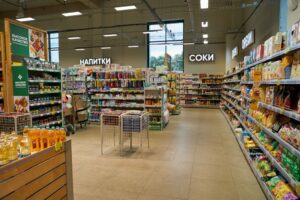Looking back the Zero-COVID Policy from China’s Current Situation
 China set a real economic growth target of around 5.0% for 2023 at the National People’s Congress held in Beijing on March 5. 2022 economic growth was only 3%, failing to meet the 5.5% target.” The “Zero-COVID” policy worsened employment, with the youth unemployment rate reaching 17.6% in 2022, more than 3% worse than in 2021. Tax revenues also fell by 3.5%. Therefore, the Chinese government has been trying to revitalize the economy by increasing the scale of fiscal mobilization starting in 2023. The target rate for the fiscal deficit against GDP has been raised from 2.8% in 2022 to 3.0% in 2023.
China set a real economic growth target of around 5.0% for 2023 at the National People’s Congress held in Beijing on March 5. 2022 economic growth was only 3%, failing to meet the 5.5% target.” The “Zero-COVID” policy worsened employment, with the youth unemployment rate reaching 17.6% in 2022, more than 3% worse than in 2021. Tax revenues also fell by 3.5%. Therefore, the Chinese government has been trying to revitalize the economy by increasing the scale of fiscal mobilization starting in 2023. The target rate for the fiscal deficit against GDP has been raised from 2.8% in 2022 to 3.0% in 2023.
In mid-January, it was reported that 900 million of China’s population had been infected with COVID-19, and three months have already passed since the “zero-COVID” policy was drastically changed on December 7, 2022. It is said that this was aimed at gaining mass immunity, but it is also said that it has become difficult to implement the “zero-COVID” policy due to the depletion of the local government’s finances. The National Migration during Chinese New Year was also expected to reach 2.1 billion people among the country, but fears of infecting the public resulted in the movement of only 1.6 billion people. Did it work? No new explosive infections seem to have been reported.
If the current situation is true, in other words, if mass immunity can be achieved in a short period of time to protect the population from COVID-19, then what was that authoritarian “zero-COVID ” policy all about? Wouldn’t the world economy have been in so much turmoil? The International Monetary Fund (IMF), feeling good about the current situation, raised China’s economic growth rate for 2023 from 4.4% to 5.2% on January 30. We will keep an eye on China’s future movements.
Objections to the U.S. policy of high interest rates
 According to the Institute for Supply Management (ISM), the Non-Manufacturing Business Confidence Index (Services) for February came in at 55.1, above market expectations of 54.5. The index had temporarily ceased exceeding 50 for two years and seven months in December 2022, but it exceeded 50 again in January of this year and has been above 50 for two consecutive months in February. Business conditions are favorable in the real estate, transportation/warehousing, lodging/restaurants, and other sectors. Shortages in the service sector are resulting in higher wages. We can see the current situation boosting domestic consumption and supporting the U.S. economy. It can be said that consumption has been recovering steadily this year. On the other hand, the manufacturing business confidence index is still below 50 for the fourth consecutive month at 47.7. The current situation is being seriously affected by the Federal Reserve Board’s (FRB) continued interest rate hikes. High inflation, which the FRB is worried about, may be theoretically wrong, but it could be overcome surprisingly quickly by reverse therapy that would stop the high-interest-rate policy. We would like to challenge the Federal Reserve Board (FRB) on its high interest rate policy that is affecting the world.
According to the Institute for Supply Management (ISM), the Non-Manufacturing Business Confidence Index (Services) for February came in at 55.1, above market expectations of 54.5. The index had temporarily ceased exceeding 50 for two years and seven months in December 2022, but it exceeded 50 again in January of this year and has been above 50 for two consecutive months in February. Business conditions are favorable in the real estate, transportation/warehousing, lodging/restaurants, and other sectors. Shortages in the service sector are resulting in higher wages. We can see the current situation boosting domestic consumption and supporting the U.S. economy. It can be said that consumption has been recovering steadily this year. On the other hand, the manufacturing business confidence index is still below 50 for the fourth consecutive month at 47.7. The current situation is being seriously affected by the Federal Reserve Board’s (FRB) continued interest rate hikes. High inflation, which the FRB is worried about, may be theoretically wrong, but it could be overcome surprisingly quickly by reverse therapy that would stop the high-interest-rate policy. We would like to challenge the Federal Reserve Board (FRB) on its high interest rate policy that is affecting the world.
U.S. West Coast Labor-Management Negotiations Conclude
The International Longshore and Warehouse Union (ILWU) and the Pacific Maritime Association (PMA), the U.S. West Coast dockers’ union, announced in a joint statement on February 27 that negotiations are expected to reach a conclusion. This is due to a sense of crisis felt by those involved for the shift in import routes from Asia from via the West Coast to via the East Coast. In reality, the ratio of U.S. West Coast lifting is decreasing by 2.7%, from 61.5% in 2021 to 58.8% in 2022. According to the Japan Maritime Center, outbound container traffic from 18 Asian countries/regions to the U.S. in January was 1,468,000 TEU, down 20% from the same month last year, marking the fourth consecutive month of double-digit declines. On the other hand, it is undeniable that, in anticipation of the forecast by the National Retail Federation (NRG) for port disruptions, the problem of over-abundance of goods imported well in advance has not been resolved, resulting in lower import volumes, which in turn has affected the decline in West Coast handling volumes. I think that the U.S. West Coast port labor-management negotiations are an example of a process that has worked because it was not rushed and took a reasonable amount of time. If the labor agreement that expired on July 1, 2022 is not settled this time and a strike is held for several weeks on the U.S. West Coast, more than 100 container ships staying on board, container shortages, sharp rise in container freight rates, and cargoes will be shifted from the West Coast to the East Coast, causing congestion at the East Coast ports.
The supply chain disruption caused by COVID-19 might be temporarily replicated. In any case, we are glad to hear that the situation seems to be safely under control.
Container Freight Rate Decline Spurs Increase in Standby Vessels
Container freight rate index announced by Drewry, a U.K.-based maritime consultancy, fell 2% from the previous week, marking the eighth consecutive week of decline.
| Container Freight Rate Index by Drewry Mar.2,2023 | |||
| Voyage Name | US$/FEU | month-over-month | year on year |
| Overall index | $1,859 | -2% | -80% |
| Shanghai /Rotterdam | $1,593 | -2% | -88% |
| Shanghai /Los Angeles | $1,948 | -1% | -82% |
| Shanghai /New York | $2,772 | -4% | -79% |
According to AXS-Alphaliner (France), a maritime research firm, 32 container vessels with a capacity of more than 23,000 TEU will enter into service this year. The top 11 Container Carriers by Volume are expected to deploy a total of 89 container vessels of 7,000 TEU or more this year. In addition, according to the company, global container vessels standby capacity has increased to 6.2% of the total fleet of 366 vessels and 1,616,569 TEUs, more than doubling the number of standby vessels on commercial from 21% in the same period last year. Despite this, they expect freight rates to become even more competitive as space becomes available and there is concern about a decline in the vanishing rate.
Rising prices of new/used containers and CLB freight rates due to the special demand in Russia. The used car market is also affected.
 The other day, a TV news reported on the current situation of a supermarket in Russia and explained that there is no shortage of goods, with many products on display as before. It is no wonder, then, that a large amount of general consumer goods are being exported from China to Russia, and there seems to be a special demand for Russian trade. The reality is that Chinese companies are taking over for European companies that have left, and necessary goods are being transported from Shanghai via the China Land Bridge using containers. Shipping companies and major container leasing companies are not able to provide containers due to the sanctions imposed by Europe and the U.S. Since China Land Bridge rail transportation has an age limit on containers, it appears that the third sector is providing newly built containers. As a result, even with the current global surplus of containers, Chinese container makers are receiving orders, filling the production lines to some extent and raising the price of new containers. On the other hand, in the Central Asian region, which is booming due to the special demand in Russia, many containers are being stalled due to congestion in rail transport. It is said that the cost of rail transportation from China to Russia is $13,000/40f, and $9,000/40f for truck transportation. Freight rates are rising due to special demand in Russia.
The other day, a TV news reported on the current situation of a supermarket in Russia and explained that there is no shortage of goods, with many products on display as before. It is no wonder, then, that a large amount of general consumer goods are being exported from China to Russia, and there seems to be a special demand for Russian trade. The reality is that Chinese companies are taking over for European companies that have left, and necessary goods are being transported from Shanghai via the China Land Bridge using containers. Shipping companies and major container leasing companies are not able to provide containers due to the sanctions imposed by Europe and the U.S. Since China Land Bridge rail transportation has an age limit on containers, it appears that the third sector is providing newly built containers. As a result, even with the current global surplus of containers, Chinese container makers are receiving orders, filling the production lines to some extent and raising the price of new containers. On the other hand, in the Central Asian region, which is booming due to the special demand in Russia, many containers are being stalled due to congestion in rail transport. It is said that the cost of rail transportation from China to Russia is $13,000/40f, and $9,000/40f for truck transportation. Freight rates are rising due to special demand in Russia.
Currently, there is a demand for old containers for sale in the Kanto region, resulting in a shortage and higher container prices. This is thought to be due to demand for used car exports to Russia. According to the International Automobile Dealers Association (iATA), the number of used cars exported from Japan in 2022 was 1,237,814 units, up 1.0% from the previous year, with 213,526 units destined for Russia, accounting for 17% of the total. Here, too, there was the special demand in Russia. This is the cause of high used car prices. Even without the special demand in Russia, used Japanese cars are very popular, so we hope that the government will make the wise decision to stop exports to Russia.
Newbuild Container Prices for February 2023
The February 2023 newbuild container price increased by $50 to $2,150 per 20f. The February newbuild container count was 69,917 TEU (Dry: 58,580 TEU, Reefer: 11,337 TEU). Newly built containers in the factory totaled 932,709 TEU (Dry: 870,290 TEU, Reefer: 62,419 TEU). Down 33,897 TEU from last month. The number of units shipped from the factory in February was 103,814 TEU (Dry: 91,164 TEU, Reefer: 12,650 TEU)
Expect consumption to increase due to the lifting of mask rule
 For whom has long refrained from going outside due to the COVID-19 disaster, the reality of the human psychology, that craves the outdoors from indoors, seems to be universal as a human behavioral science. Even in sluggish Japan, department stores, shopping malls, and theme parks are crowded with many people wearing masks. Cheering enthusiastically at sports games is an essential stress reliever. The Ministry of Health, Labor and Welfare has decided to leave the wearing of masks to individual judgment starting next week, March 13. In some cases, wearing a mask is recommended, but not mandatory.
For whom has long refrained from going outside due to the COVID-19 disaster, the reality of the human psychology, that craves the outdoors from indoors, seems to be universal as a human behavioral science. Even in sluggish Japan, department stores, shopping malls, and theme parks are crowded with many people wearing masks. Cheering enthusiastically at sports games is an essential stress reliever. The Ministry of Health, Labor and Welfare has decided to leave the wearing of masks to individual judgment starting next week, March 13. In some cases, wearing a mask is recommended, but not mandatory.
It is very good for the human spirit that the fear of COVID-19 infection is diminished and many people can regain the joy of going out in safety, talking with friends, enjoying food and drink, and so on. I expect that consumer activities will flourish with demand for fashion, new car purchases, and increased eating out. However, in my case, hay fever has become more pronounced since last week, and I cannot stop sneezing, running my nose, crying, blowing my nose too much, and even getting nosebleeds, which is very terrible condition, so I will not be able to take off my mask for a while.
(Translated by Mr.Masaki Nakatsu)